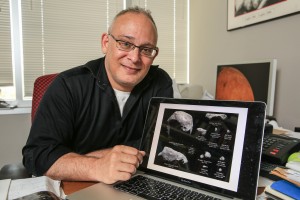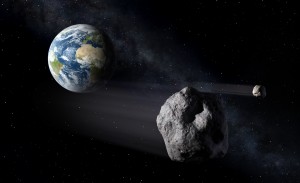
It’s an inside job. Richard Miller is part of a NASA NIAC-funded research team that could influence future asteroid mining operations and how to deal with an impending asteroid strike. Credit: Michael Mercier/UAH
A nasty asteroid headed toward Earth is on a collision course – how best to protect our home turf?
First of all, knowing its density and structure is important. Is it a rubble pile, solid as rock, Swiss cheese, has a core, or something else?
With that information in hand, dealing with the threatening object should become less than a celestial crap shoot.
And that’s not all. This type of asteroid make-up knowledge can influence future asteroid mining operations.
CT scan
It’s an inside job according to Richard S. Miller, a University of Alabama in Huntsville (UAH) physics professor. He is part of a research team borrowing imaging technology concepts developed for medicine and high-energy physics.
They are developing a mission concept to probe asteroids using a technique similar to human computerized tomography (CT) scans.
“What we want to do is actually probe the interior of asteroids and determine information about their structure,” Miller said in a UAH press statement.
Backing the research is a newly awarded $500,000 in funding from the NASA Innovative Advanced Concepts (NIAC) Phase II program. The team’s two-year proposal is titled: “Deep Mapping of Small Solar System Bodies with Galactic Cosmic Ray Secondary Particle Showers.”
UAH’s Miller is a co-investigator in a collaborative effort with the Planetary Science Institute (PSI), NASA’s Johnson Space Center, the Universities Space Research Association’s Arecibo Observatory (Arecibo/USRA) and the University of Houston to do the fundamental research and design that could lead to such a mission.
The idea is to position a telescope to orbit an asteroid and measure the number and trajectories of the muons passing through it.
By detecting the number of muons that pass through the object, scientists can discover and measure the size of the object’s core.
Miller said that an asteroid composed of varying densities of material would return a different pattern than one with a single density – just as a CT scan differentiates between densities of structures in the body, he said.
Likewise, if an asteroid has a denser core, it will stop muons from passing through and the telescope will detect the change.
Fundamental challenges
The process is called muon tomography and is well understood. Developed in the 1950s, it was even used in the 1960s by Luis Alvarez to map the Pyramid of Chephren.
Thanks to the NIAC funding, the scientists are tackling a number of fundamental challenges.
For example, the team will be using computer modeling to blueprint how a proposed NASA mission would be conducted, its feasibility and making predictions of the ultimate science return.

